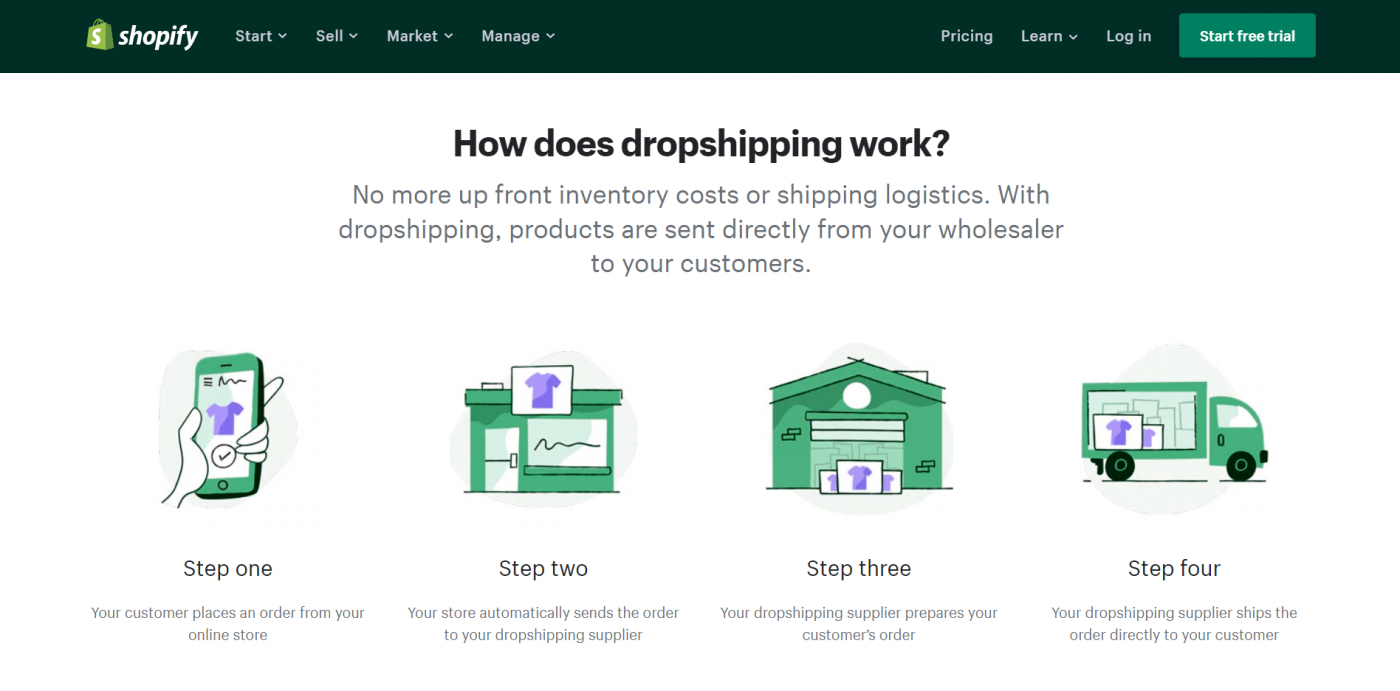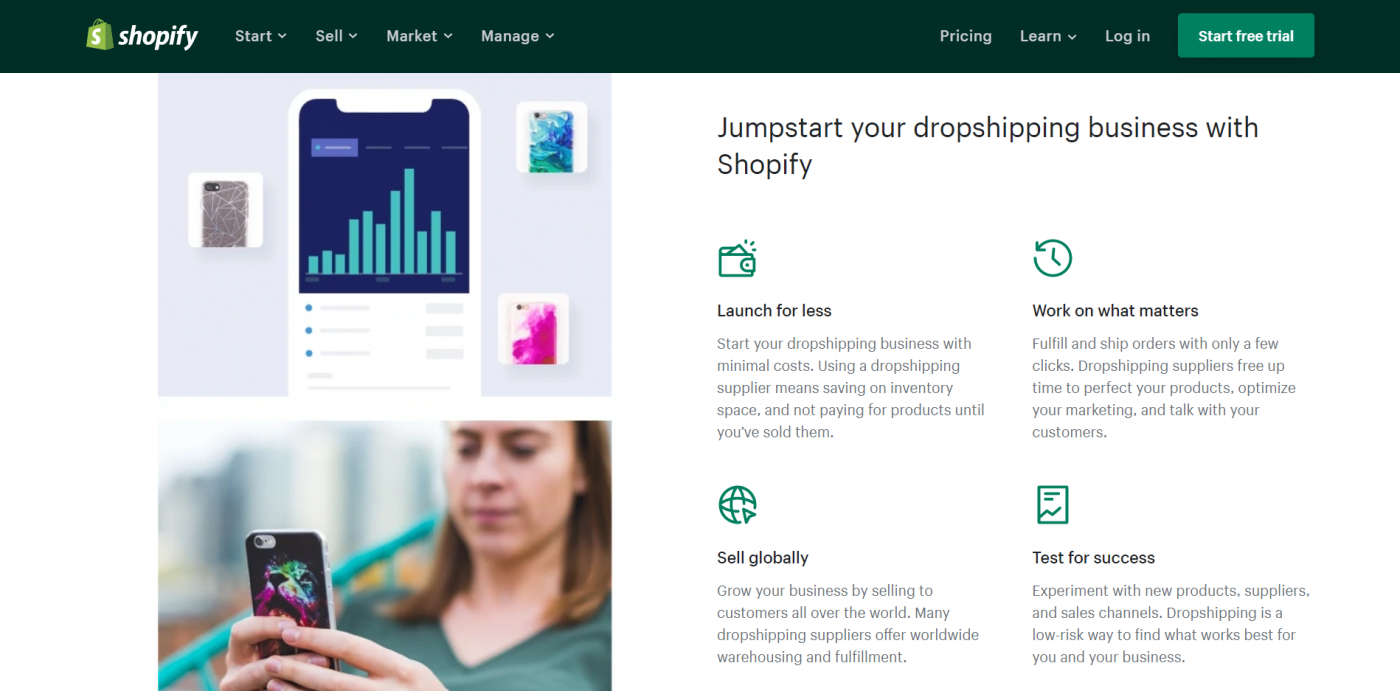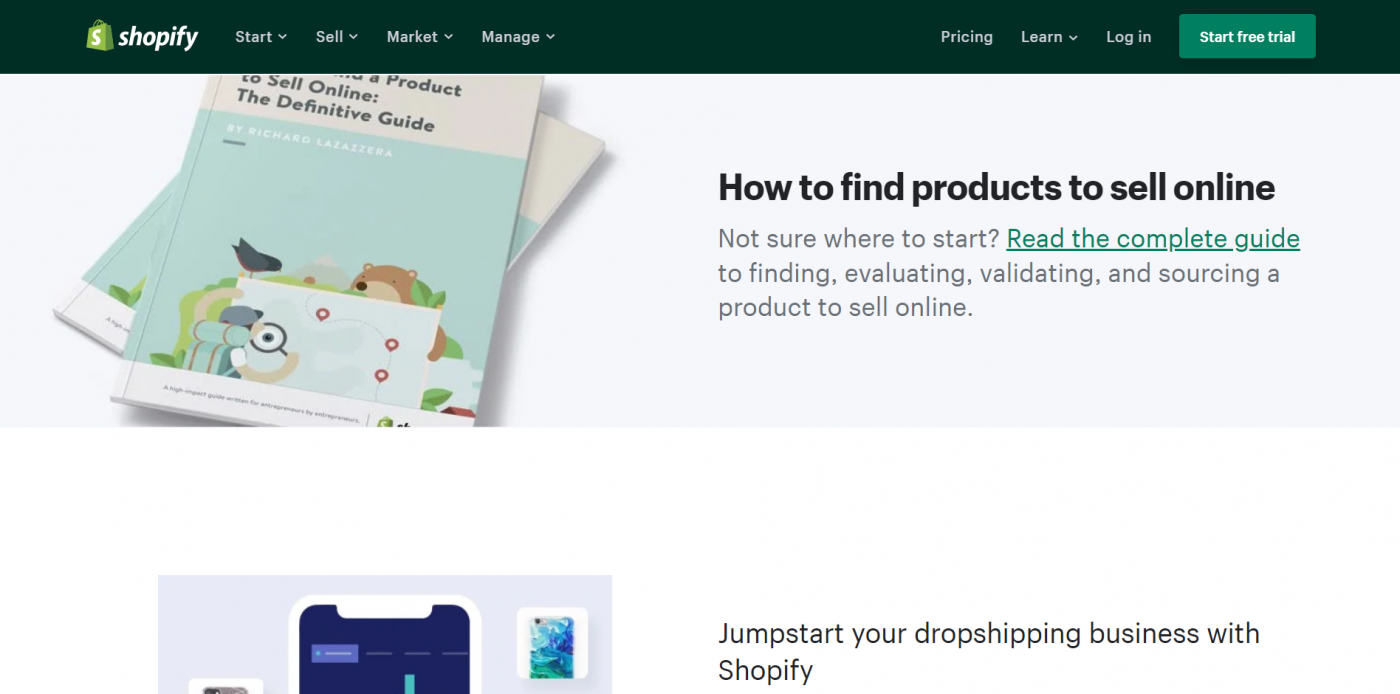Dropshipping on Shopify has been constantly growing in popularity lately. Thanks to Shopify’s native software and the enormous ecosystem of integrations, this e-commerce platform has created optimal conditions for dropshipping businesses to flourish.
There are so many success stories out there that inspire more and more people to dip their toes in the waters of dropshipping and start their own business ventures.
If dropshipping is a topic you’ve been toying with for a while, you might want to learn a bit more about it. If dropshipping on Shopify specifically has your interest, this article may help you. Here, we’ll examine what dropshipping is, how it works, and why Shopify is one of the best environments for running a dropshipping business.
On top of this, we’ll talk about some of the recommended ways to go about dropshipping on Shopify. So, without further ado, let’s get to it.
Table of Contents
What Is Dropshipping?
Chances are, you’ve already done some research, and you’re already familiar with the concept of dropshipping. Nonetheless, there are many e-commerce enthusiasts for whom dropshipping is still a confusing notion. Luckily we’re going to smooth it all out for you.
Dropshipping Defined
In essence, dropshipping is a very specific method of order fulfillment. Dropshipping comes down to selling products that you don’t produce, keep in stock, or ship.
Shopify store owners who utilize this e-commerce model usually list and sell products that they find on huge online marketplaces like AliExpress, Alibaba, and eBay. The difference between the original price and their own selling price is where Shopify store owners make their profit. Of course, you also have to factor in marketing and selling costs as well.
What’s specific about dropshipping is that you pay for a product you sell only after someone has bought it from you. You don’t need to make bulk orders or pay for large quantities of products in advance, which means you avoid the risk that you can’t sell them. Dropshipping doesn’t require you to store products in a warehouse either, freeing you from any inventory-carrying costs.
In dropshipping, your task as a merchant is to market and sell products and take care of customer support – that’s it. However, this is something that you need to do extremely well.
How to Be Good at Dropshipping?
Many entrepreneurs who dropship on Shopify are marketing experts, and some report spending thousands of dollars on marketing. Good customer service and highly-developed marketing skills are often what make the difference between a successful dropshipping business and a failed one.
Technically, the real dropshippers are the companies that supply, ship, and pack the products that you sell. You, as a dropshipper with a Shopify store, are an entrepreneur who runs a dropshipping business, not a dropshipping service provider per se.
Product suppliers need merchants and marketers to reach larger audiences and sell more products. You need product suppliers that store and ship products to cut the costs involved in a traditional retail business. So, you see, it’s a bit of a never-ending loop.
Dropshipping in a Nutshell
For a more visual illustration of dropshipping, take a look at the following short but informative explanation offered by Shopify:
So, if you were wondering how it is possible for the dropshipping model to work at all, try to think of it as a significantly more convenient way of running a retail business. In the end, you’re just a retailer without the headache and overhead of the classical retail business.
Dropshipping Supply Chain
To understand this e-commerce phenomenon better, we need to learn more about the main actors in dropshipping. The dropshipping supply chain consists of three elements: manufacturers, wholesalers, and retailers – dropshipping store owners belong to this last category.
Manufacturers
Manufacturers, obviously, are companies that produce the goods you sell. The majority do not sell directly to consumers but rather to wholesalers or directly to retailers. This means that you can communicate and cooperate directly with manufacturers without a middleman if you so choose.
This can pay off in higher profits, considering that products are at their cheapest when you buy them directly from the company that makes them, but there’s a drawback. You’ll have to consider the storage of your products because manufacturers usually do not offer this type of service.
In addition to this, cooperation of this kind usually includes ordering products in bulk. Ordering even the minimum required quantity can still be a lot since manufacturers normally do not sell products in small quantities, let alone individually. In fact, this issue – along with the storage problem – is one of the main reasons why Shopify store owners who run dropshipping businesses generally choose to buy from wholesalers.
Wholesalers
Wholesalers play the role of a middleman. They buy large quantities of products from manufacturers and sell them to retailers. As a rule, similar to manufacturers, they don’t sell directly to consumers.
For the bulk of the merchants who dropship on Shopify, their product suppliers are companies who do wholesale. As we already mentioned earlier, they are the ones who also take care of storing and shipping.
Even in cases where wholesalers require minimum purchase quantities, these quantities are smaller than what you would have to buy if you were ordering products directly from the manufacturer.
Retailers
Retailers work directly with consumers. As we said, Shopify store owners who run dropshipping businesses are the retailer.
The Pros of Dropshipping
Now that you know what dropshipping is and how it works, let’s see some of the reasons why it has become such a popular e-commerce activity. As you’ll notice yourself, many of the positives of dropshipping are closely related.
1. Dropshipping Is Economical
Dropshipping saves you a lot of money and time since you don’t need to handle anything but sales, marketing, and customer support. In addition to this, as it doesn’t require you to pay upfront for the products you sell, store them in warehouses, pack them, or ship them to your customers, it allows you to run a business even with a pretty modest budget.
2. Dropshipping Is Low-Risk
As you don’t need to care about every single aspect of running a business or invest a fortune in your e-commerce venture, dropshipping is an extremely low-risk e-commerce activity.
Even when you suffer losses, they won’t be nearly as big as if you were running a standard retail business. You can test new products without fear of great losses, even if things go south and nobody buys them.
3. Dropshipping Is Simple
Dropshipping is not a complex e-commerce endeavor, it doesn’t include a steep learning curve, and it doesn’t require tech-savviness, so virtually anyone can do it. This makes it a great choice for complete beginners. Doing our research, we even came across success stories of teenagers who claimed that they had great success with dropshipping.
4. Dropshipping Is Flexible
Dropshipping is so flexible that you can run your business from home. In fact, one Shopify article claims that many flourishing dropshipping businesses are home-based. Also, since it doesn’t include much logistics on your side, it’s a lot easier to scale when running a dropshipping business than a standard retail business.
On top of this, you can choose from millions of products available on AliExpress and Alibaba to sell. It’s not like you can’t do this with the standard retail business model, but dropshipping makes it a lot easier to switch gears. You can rapidly change your products and readjust the focus of your business and take advantage of all the possibilities today’s online market offers.
How to Dropship on Shopify: Tips and Suggestions
Find a Reliable Product Supplier
Finding a good and reliable product supplier is not as easy as it might seem at a glance. It can take some time and trial and error to find the right product supplier or suppliers.
The majority of Shopify store owners who run dropshipping businesses cooperate with more than one product supplier. Chances are, you’ll also have to find multiple product suppliers, although this will depend a lot on how you view your dropshipping business and store.
If you prefer brand-building above everything else and plan to make your Shopify store revolve around your brand, then selling only one product and long-term cooperation with a single product supplier might be a better idea than selling multiple products and working with multiple product suppliers.
A good and reliable supplier is one of the pillars of a successful dropshipping business. AliExpress and Alibaba both offer a ton of options when it comes to choosing one, but don’t think you’re limited to just these two. There are plenty more suppliers, like SaleHoo and Worldwide Brands to name just a couple.
One such possibility is to put your brand on products and packaging. However, keep in mind that suppliers that offer additional perks like this may require you to meet some extra criteria.
Find a Specific Niche
Some merchants suggest operating in a niche that has to do with something consumers are emotionally attached to, such as children (for instance, you can sell toys or clothing) or pets (pet beds and accessories).
When choosing a niche, it’s highly recommended to focus on a very specific niche market rather than having a broad range of products. This is the advice of virtually every experienced and successful Shopify entrepreneur. The more specific your product and target audience are, the higher the chances for success.
Do Extensive Marketing
Advertising and marketing are key to success in dropshipping. As long as it’s well-thought-out and organized, anything will do, whether it’s search engine marketing or social media ads.
What kind of ads do you need to attract leads? Ads that sound like they address and solve very specific and practical problems. In addition to this, they need to provide an answer to this one question: what special value do your business and products bring to your customers?
Unless you’ve already managed to build a strong following somewhere else, there’s a high probability that your Shopify store won’t get any significant traffic from the get-go. You should expect to work long and hard on creating a steady stream of traffic to your store.
For some Shopify store owners, things change when they start engaging influencers to bring more traffic to their stores. For others, the answer is content marketing.
Luckily, Shopify integrates with tons of apps, and you can find everything you need to start creating content, blog effectively, and boost your SEO in one place: the Shopify App Store.
As far as blogging is concerned, DropInBlog can help a lot. It’s a modern platform that integrates with Shopify and, for that matter, any other major player in the world of sales and marketing platforms and site builders. Platforms such as ActiveCampaign, Kartra, HighLevel, BigCommerce, and Webflow all integrate with DropInBlog as well.
DropInBlog also includes a built-in SEO Analyzer that’s based on current SEO best practices. For more information on DropInBlog and blogging on Shopify, check out this article.
Rome Wasn’t Built in a Day
Building a successful dropshipping business is not easy. Many entrepreneurs who dropship on Shopify went through some hard times until their businesses started to take off.
So, do not get discouraged if your business doesn't skyrocket to success instantly. Sometimes it takes time for good things to happen. It may take months or more than a year until you start seeing any good results from your efforts.
In the meantime, advertise your store on social networks like Facebook and work hard on building your brand. Regardless of whether your products come from AliExpress, Alibaba, eBay, or elsewhere, they need to look good and satisfy some quality requirements.
The same applies to packaging, as well as your store: the more professional they look, the more credibility your business will have. We can’t emphasize enough how important design is in the context of professionalism and sending the right message to your audience.
Good customer support is another crucial aspect of a successful dropshipping business that can put you in a solid position from the very beginning. Quick response time, specified hours of availability, phone support, and transparency – all these can make the difference between a failed and successful business.
What Products to Sell
Up until now, we haven’t gone into detail about finding products to sell. Why did we do that when it’s undoubtedly one of the most important aspects of a dropshipping business? It’s exactly because of its importance that we wanted to go into it in detail.
How to Find the Right Product
AliExpress offers over 100 million products, and it’s just one marketplace. Can you imagine the total number of options when you add unique products from other online marketplaces? It’s hard to know where to look and what to do when there are so many choices out there. Luckily, a little research and recommendations by people in the know can help a lot.
If you plan to focus on the local market, one of the things you can try is to do some local market research and see the current trending products in your area. Another good idea would be to sell something that’s hard to find in your area, but you know for sure that people want or need it.
In case you can’t find online resources, ask around and see what recommendations people who’ve been in dropshipping for a while have.
Generally speaking, whether or not you intend to work in a global or local market, there are some types of products that could work in most scenarios. For instance, products related to hobbies can be a good idea. People are often willing to splurge and treat themselves when it comes to their hobbies. Sports, gaming, and music can be highly profitable areas.
You can almost always find buyers for sports and music equipment or gaming accessories.
Alternatively, selling disposable products that are part of our daily lives that people need to buy on a regular basis, such as cosmetics and personal care products, is another good option.
Product Recommendations for 2023
The following list is some of the trending categories and subcategories of dropshipping products and can be of great help to someone who’s starting out:
- Apparel and footwear: kimonos, swimsuits, sportswear, or sundresses
- Beauty and personal care: skincare, cosmetics, fragrances, or specialist vegan products
- Kitchen and dining: coffee pods, air fryers, or reusable eco-friendly products
- Baby: diapers, water-based wipes, stroller fans, or chew toys
- Pet supplies: hair remover, poop bags, slow feeder bowls, or dog toys
- Home interiors: air purifier, blankets, and orthopedic pillows
- Phone accessories: mobile skins, iPhone tripods, and portable green screens
These recommendations are based on market research and Google Trends stats. If you want to find out more on this topic, check out this Shopify blog post.
If you dig a little deeper into the Shopify official blog, you’ll find some extremely helpful information related to product sales forecasting. One such blog post deals with what are expected to be popular products to sell in the coming year.
The following list contains the top ten products based on the global order year-on-year growth that can be a good idea to sell online in 2023:
- Power tool accessories: 23,418% growth
- Dog toys: 13,357% growth
- Costume shoes: 8,877% growth
- Laptop batteries: 8,305% growth
- Shot glasses: 8,178% growth
Price
Pricing your product the right way can sometimes be as important as choosing the right product. Even the best product won’t help you if your price is unrealistic. Since more and more merchants are doing dropshipping and there’s so much competition nowadays, steep prices can put you in an unfavorable position. No one wants to buy overpriced products.
On the other hand, a price that is too low can make customers suspicious of an item’s quality. Finding a price range that is just right can be difficult but not impossible.
As a general rule, when pricing your product, you need to take into account the entire cost of a product, including product marketing. In order for you to make a profit, your price has to cover the original price, what you spend on marketing the product, and still leave a little extra as profit.
It goes without saying that you also need to take into account the current market price for the type of product you’re selling.
Product Size and Material
Another thing that you need to consider when choosing a product is its size. The fact that you’re not directly responsible for shipping your product doesn’t mean that it’s all the same, whatever size of product you sell. In this case, the golden rule is to go for smaller rather than large, cumbersome products that can be easily damaged in transit.
As far as the material is concerned, fragile or delicate products, as you can imagine, are not recommended.
Oberlo and Other Helpful Tools
Oberlo is a dropshipping app that was built by Shopify itself. It provides a connection between Shopify and AliExpress so that you can quickly and easily find products and add them to your online store. It’s not a part of the out-of-the-box feature set, but you can easily install it from the Shopify App Store.
Alternatively, since there’s a separate Oberlo page on Shopify, you can sign up for a free trial from there as well, or just go to the Oberlo stand-alone official website and explore the options available there.
In regard to pricing, Oberlo offers a free plan called Explorer and a paid plan called Boss:
What’s so special and important about this app? The short answer is, Oberlo provides convenience that’ll make your life as a Shopify dropshipping store owner so much easier. The longer answer is that Oberlo helps you solve one of the most important parts of the dropshipping puzzle: finding a winning product.
On top of this, when a customer buys a product from you, Oberlo automatically forwards this order to your product supplier and fills in all the necessary information. Your job is just to double-check if all the information is right and place the order. Your product supplier then sends the product to your customer. It’s that easy.
Moreover, Oberlo allows you to track whether a certain product is out of stock. When it’s not available anymore, you can set automatic actions like removing the product from your store or just showing your customers that the product is no longer available by letting Oberlo change the quantity to zero. In short, Oberlo is one of the most convenient ways to dropship on Shopify.
Other Helpful Apps
Besides Oberlo, there are other apps with a similar function that you can integrate into Shopify. Here, we singled out three integrations available in the Shopify App Store.
CJDropshipping
The following list shows some of the key CJDropshipping features:
- It offers fast shipping to the USA.
- It provides a ton of products whose prices are lower than those on AliExpress.
- It offers millions of different products, but in case you can’t find something, it allows you to request that product.
- It allows you to import products from its website.
- It’s free to install and use.
SupplyMeDirect
SupplyMeDirect has the following noteworthy features:
- It offers quick shipping.
- It works in three large markets: the USA, the UK, and the EU.
- It offers private labeling as a part of its services.
- It’s free to install and use.
Modalyst
Modalyst is a bit different from the previous two apps because it includes high-end products from famous brands like Calvin Klein and Dolce & Gabbana in its offering. In addition to this, it has the following features:
- A free plan – but for more advanced features, you’ll have to pay $35/month or $90/month, depending on which plan you choose.
- Modalyst Private Label Program – allows you to have your own branded products.
The Cons of Dropshipping
Right now you’re probably thinking dropshipping seems like a quick and easy way to earn some big money. The concept of dropshipping certainly sounds like something that’s too good to be true, but hold that thought because there are some notable downsides.
We need a reality check to get our feet firmly on the ground. There are always some tradeoffs that we need to be aware of before deciding to jump in the deep end with a dropshipping business.
A Lot of Competition
As we already mentioned, dropshipping has become an extremely popular form of e-commerce recently. Due to its many pros, many e-commerce enthusiasts have started their own dropshipping business for the same reasons you want to start.
Competition can be a good thing, but a lot of competition can adversely affect your business. Since lowering your prices is often the most visible and tangible way to stick out from the crowd, many entrepreneurs resort to this tactic to keep their businesses competitive.
The truth of the matter is that this works, but the problem is that it can be a slippery slope. When the majority decrease their prices, sooner or later you’ll have to do the same to stay in the game.
Decrease your prices too much, and, in the end, you’ll see your profit margins decrease significantly.
Limited Customization
Dropshipping doesn’t leave much room for customization. In certain cases, your product supplier can put your logo on the product you sell, but as we said earlier, this comes with some strings attached. You may have to order products in larger quantities, which defeats the purpose of the dropshipping e-commerce concept.
Very Little Control
Because you are outsourcing a large portion of your business, you’re at risk of things like bad packaging, mistaken orders, or damaged or missing products. The worst part is that when these situations occur, you’ll be the one held responsible.
It can be very frustrating to take the blame for someone else’s mistake, but when this starts to affect your business reputation in the form of negative customer reviews, it will hurt even more.
However, this can often be salvaged with good customer support on your side. Alsо, it goes without saying that if errors like these continue to occur, you should start thinking about finding a different product supplier.
FAQs
How can I enable dropshipping features on Shopify?
In order to enable dropshipping, you’ll have to connect your Shopify store with a dropshipping provider. There are plenty to choose from in the Shopify App. Once you’ve done that, you simply import the products you want to sell in your store – but don’t forget to do your market research first.
Are all Shopify stores equipped with dropshipping features?
Shopify has three standard pricing plans, and dropshipping is possible with even the lowest tier plan. The Basic plan for $24/month will give you and one other staff member access to the account to sell up to 1,000 products from your store.
Is Shopify good for dropshipping?
Shopify is perfect for dropshipping. In fact, it’s the leader in e-commerce. It’s super simple to set up a Shopify store. Then, you just connect your selected dropshipping provider, and away you go! It’s made to be super easy, and this is probably why it’s so popular amongst dropshipping businesses.
Over and Out
Dropshipping is an interesting and extensive topic, with competition increasing and changing the game every year. We touched on every or at least most of the significant aspects of this e-commerce model.
Now that you know more about the pros and cons, what do you think – is dropshipping worth it? Is it better to stick to the classical retail business model? Or maybe it’s best to build a fully-branded Shopify store that sells unique products made by someone you already know and trust? We think there’s still a lot of potential for dropshipping to grow even further.









